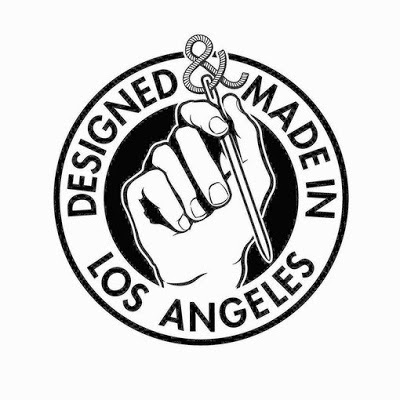Home » Made in the US » Made in Los Angeles: Branding Local Fashions
Made in Los Angeles: Branding Local Fashions
While the idea of promoting domestically produced apparel seems like a great idea, the reality of organizing, marketing and implementing any such program is much more involved and political that it seems on the surface.
We can all agree that we want to know more about where our apparel comes from. 'Country of Origin' tags inside our clothes help to list that for us, but hang tags can emphasize that even more. Over the past decade, Los Angeles has become a top of apparel design and manufacturing region. While labels here may produce their product locally, at this time there isn’t any local hang tag to note that for the shopper. Some brands do carry the “Made in California” logo, but the actual state region is not listed.
In an attempt to brand the city of Los Angeles as a fashion capitol for design through manufacturing, the mayor has released a new logo promoting L.A. fashion. Intended as a label or hang tag, it boasts “Designed & Made in Los Angeles”. Behind this label is a new program to promote Los Angeles’s apparel industry, create resource guides, and other means of support for local companies.
The “Made in California” program already exists, and for some companies that is a strong branding tool that some aren’t in a hurry to trade off for the new localized tag. Another concern is that manufacturing in the Los Angeles region spreads wider than the city boundaries. The new “Made in L.A.” logo must be supported by performing all design and manufacturing functions with-in the city limits.
Rozae Nichols, who designs and produces her high end fashions in the city and is a well known proponent of local design and manufacturing injected a note of reality to the proposal to comment that for her, to produce off shore isn't always bad for her business.
Trina Turk also commented that she is already using the "Made in California" logo. She also noted that her customer is more concerned about style and fit when making their purchase. Turk’s line has long been designed locally and a significant portion of the products are manufactured in the region. She went on to point out that because of labor costs, she can only produce her more simple garments in the city. Items requiring more labor are made off shore. This is essential for keeping her price points in line with the market.
There is a concern that this new program has the requirement for all design and production to be Los Angeles city based. This is where simple to manufacture T shirt and sport clothing manufacturers such as American Apparel can be successful, while garment designers whose product is more complex must still seek off shore production. This creates a ‘split’ manufacturing concept with both local and off-shore production.
Will brands with this method of manufacturing be able to carry the tag? Will various products by one label be tagged, while other items in the line are not? These and other questions remain to be answered.
Many local but California designed and produced brands will be ‘out’ in this game. By confining the hang tag to companies located only in Los Angeles many labels designed in the city but manufactured in the San Fernando valley (where many are located in what had been the center of the aerospace industry in the mid-century), and the vast areas of L.A. county’s industrial belt will be ‘out’. This could make selecting a contractor tricky at best for the L.A. based design house.
It is important to understand that many companies have design rooms located in the city core, but the manufacturing process might be located further away in other cities and unincorporated county sites that offer less expensive locations to rent and maintain.
Another concern is what the hang tag will mean as a brand. Los Angeles produces a wide and diverse selection of apparel. This range covers items that will be sold at low price points on up to nearly couture level garments. How will the localized branding cover this stretch in quality and price points?
It may be difficult to ‘sell’ the idea of a regional tag to the higher priced design companies, since cheaply produced apparel will be able to carry the same hang tag along with their higher priced labels. The city logo won’t be able to signify high quality or design superiority.
Perhaps the mayor’s announcement (timed with the Spring Fashion Week in L.A. in October) was premature. The obvious support such an initiative requires, such as a web-site and resource lists and more importantly a large team of labels and manufacturers on board for support are as yet unformed. With only 19 out of 10,000 companies supporting this logo, most are taking a ‘wait and see’ position on this new concept.
To read more:
Los Angeles hopes to make a fashion statement
October 21, 2012|By Adam Tschorn and Booth Moore | Los Angeles Times
A PDF file of this article can be found HERE:
Made in Los Angeles: Branding Local Fashions


Reviewed by Unknown
Published :
Rating : 4.5
Published :
Rating : 4.5
Related Posts: Designed and Made in Los Angeles,
Designed in Los Angeles,
L.A. fashion industry,
L.A. garment industry,
Los Angeles garment industry,
Made in California,
made in Los Angeles,
Made in the US





Tidak ada komentar:
Posting Komentar